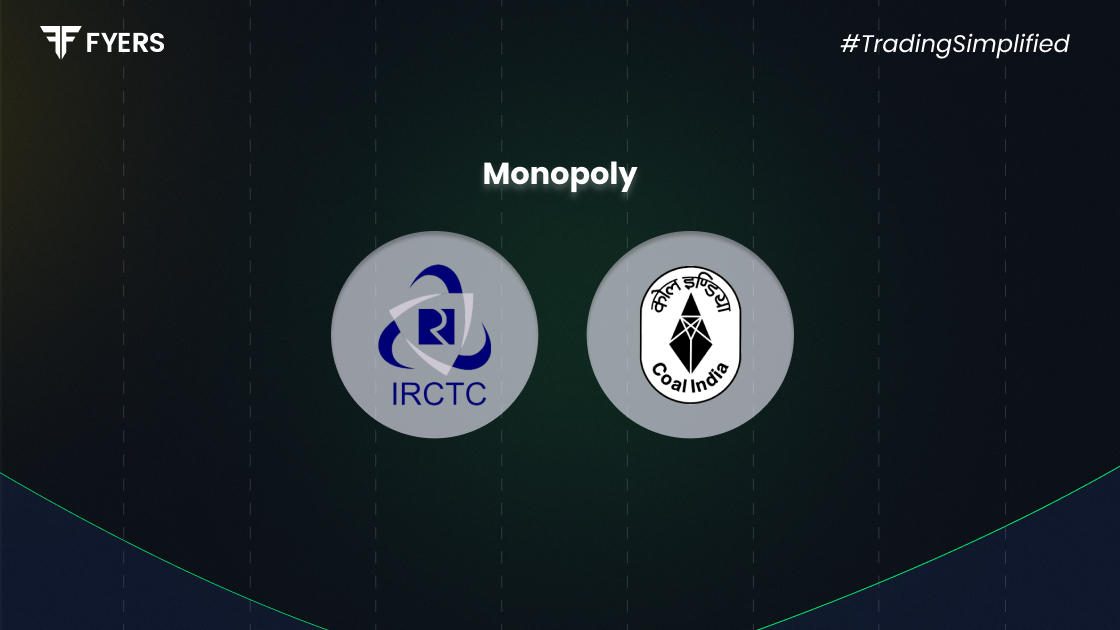

 21 Jul, 2025
21 Jul, 2025
 4 mins read
4 mins read

In a rapidly evolving stock market, where new entrants regularly challenge the old guard, a few names continue to stand tall. Among them, IRCTC and Coal India are two of the most prominent monopoly stocks in India. Despite growing competition and sectoral reforms, these companies continue to dominate their respective industries — Indian Railways' catering and ticketing, and coal mining.
But what gives these firms such staying power? And are they still worth your attention as an investor?
In this article, we’ll explore why IRCTC and Coal India are considered top monopoly stocks in India, how competition is shaping their future, and what keeps them attractive despite the challenges.
Monopoly stocks in India are shares of companies that operate with little to no competition in their sectors. These firms either have exclusive government licences, control key infrastructure, or own intellectual property that gives them significant market power.
Market dominance with high entry barriers
Regulatory or structural advantages
Steady demand for their products or services
Long-term revenue visibility
Investors often view Indian monopoly stocks as stable, defensive picks with strong pricing power — particularly appealing during economic uncertainty.
IRCTC (Indian Railway Catering and Tourism Corporation) is a PSU (Public Sector Undertaking) with a monopoly over online railway ticket bookings, catering, and packaged drinking water (Rail Neer) for Indian Railways.
Despite emerging travel apps and digital wallets offering ticket booking interfaces, the backend services still run on IRCTC’s infrastructure.
Exclusive rights to railway catering and online booking
Government backing and regulatory control
Low competition due to integration with Indian Railways
Steady passenger demand and high daily transaction volume
The IRCTC share price has seen substantial investor interest due to the company's consistent profits, zero debt, and near-total control over a massive and inelastic market.
Coal India Limited, the largest coal producer globally, enjoys a near-monopoly on coal mining and supply in India. It contributes to over 80% of the country’s coal production, supplying to power, steel, and cement industries — all essential for economic growth.
While private mining has opened up in recent years, Coal India still holds significant structural and logistical advantages.
Access to the largest coal reserves in India
Integrated logistics and supply chain
Government ownership ensures policy support
Strong relationships with power utilities
Even with efforts to increase renewable energy adoption, thermal power will remain a major energy source for the foreseeable future — securing continued demand and making Coal India share price a focal point for long-term investors.
Both IRCTC and Coal India are seeing increased competition, but the threat remains limited for now.
New-age platforms like Paytm and MakeMyTrip provide train ticket booking but rely on IRCTC’s platform.
The government's push for privatisation in catering services has opened up some segments, yet IRCTC still oversees the overall ecosystem.
Private miners have entered the field, especially in non-captive sectors.
Renewable energy is on the rise, but coal remains essential due to current energy infrastructure limitations.
While the competitive landscape is changing, the moats — regulatory control, scale, infrastructure, and integration — continue to protect their dominance.
Despite reforms, these two companies have several structural strengths that maintain their edge:
Government Ownership: Ensures policy support and long-term contracts
Infrastructure Control: Critical assets like ticketing platforms and mining rights
Economies of Scale: Massive operations reduce per-unit costs
Brand Trust: Public familiarity and reliability
This mix of institutional backing and scale makes them not just dominant players, but also among the best monopoly stocks in India today.
While IRCTC and Coal India dominate their niches, several other companies also exhibit monopolistic or near-monopolistic behaviour in their sectors:
Hindustan Aeronautics Ltd. (HAL) – Aerospace and defence manufacturing
Indian Energy Exchange (IEX) – Power trading platform
Container Corporation of India – Rail-based logistics
These companies, alongside IRCTC and Coal India, form a core part of many lists of top monopoly stocks in India for long-term investment.
Predictable revenue streams
Lower sensitivity to market cycles
Government backing (for PSUs)
Potential for regular dividends
Over-reliance on government policy
Slow innovation or bureaucratic delays
Regulatory changes
ESG concerns, particularly for companies like Coal India
While monopoly stocks in India offer defensive benefits, investors must watch for sectoral reforms, privatisation pushes, or policy shifts that could erode long-term advantages.
In the dynamic world of investing, IRCTC and Coal India continue to stand firm as pillars of monopoly strength. While competition and policy shifts are real, their infrastructure, government ties, and entrenched market positions ensure they remain reliable options for investors seeking consistent returns.
Whether you're tracking the IRCTC share price for momentum or looking at Coal India share price for dividend income, these stocks can play a valuable role in a balanced long-term portfolio — especially for those seeking exposure to stable Indian monopoly stocks.
They are stocks of companies with dominant market positions due to government support, structural advantages, or lack of meaningful competition.
Because IRCTC has a near-exclusive right to railway ticketing and catering, making it a highly profitable PSU with strong growth and dividend potential.
While some private mining has been allowed, Coal India still accounts for the majority of coal production and supply in India.
They typically carry lower business risk due to their dominant positions, but are not entirely risk-free — especially if regulatory or political changes occur.
Calculate your Net P&L after deducting all the charges like Tax, Brokerage, etc.
Find your required margin.
Calculate the average price you paid for a stock and determine your total cost.
Estimate your investment growth. Calculate potential returns on one-time investments.
Forecast your investment returns. Understand potential growth with regular contributions.